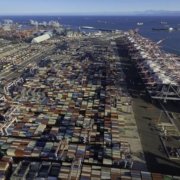Zero Emissions future – the case of the Port of Long Beach

Written by: Lidia Slawinska, Digital Communications
A net-zero operating terminal is a milestone that most ports around the globe are working towards – as it would mark a significant step towards sustainability. This summer, one port has achieved this remarkable step and begun operating a container terminal that is equipped with nearly all electric and zero-emissions equipment. Already news sources are reporting it as one of the most technologically advanced cargo terminals globally. We are, of course, talking about the Port of Long Beach – and the Long Beach Container Terminal at Middle Harbor (in California, USA) – and we wanted to take a look at it in this #DidYouKnow article.
A decade in the making
The port begun work on the project in May 2011, with an initial estimated cost of $1.5bln. The project was divided in three distinct phases. The first phase was completed in 2016, after which 151 acres opened for business. The next year the terminal was expanded to reach 191 acres, and the final phase of the project ended in July 2021. The Container Terminal now boasts with 300 acres in size, has a completed container yard, a modern administration buiding and an on-dock rail yard to allow for intermodal traffic. The concrete wharf can also receive and process three massive ships at once, with fourteen gantry cranes able to service the shoreline.
The terminal is expected to expand through the North Gate Expansion by 2025, adding an additional 3 acres to the already impressive surface area of the facility.
Net zero emissions
It is doubtlessly difficult for ports to make sure that their operations are carbon neutral – and in line with the global environmental agencies recommendations for the protection of our climate. How did the Port of Long Beach achieve its net zero emissions?
First of all – it ensured sufficient on-shore power supply stations on the berths. All of the vessels are now able to shut down the diesel engines while stationed in port and can connect to the local electrical grid.
Secondly, during the construction it was ensured that all of the major structures were built with features that allow them to save both electricity and water, meeting the American Leadership in Energy and Environmental Design standards.
In-terminal operations are carried out by automated guided vehicles that rely on transponders in the asphalt to manoeuvre around the containers. These vehicles are battery-operated and are also capable of recharging themselves.
The final aspect of the Californian terminal is the emphasis that has been placed on faster truck turnaround times, which further reduced the port’s emissions.
Intermodality at the forefront
There is no doubt that one of the aspects that port terminals can focus on is to increase their intermodal capacities – as bringing trucks off the roads would significantly lower the GHG emissions produced by their diesel engines. The Port of Long Beach was not an exception, and in its construction has included a intermodal rail yard that includes 70,000ft of tracks. “There are 12 tracks, and each is almost a mile long,” says Thomas Baldwin, director of project management at the port. “There are four storage tracks, and eight working tracks. Five dual cantilevered gantry cranes with room for a sixth. It’s one of most modern railyards ever built, with 1.1 million-TEU capacity ” (August 20th, 2021: ENR). In the near future, the port is also planning to expand its on-dock rail capacity to 35%, acknowledging that one fully stacked train can replace up to seventy-five trucks on the road – further alleviating the pressure on our environment.
Innovating into a clean energy future
Becoming a green port is no small feat. There are many innovative ports in the world that have already incorporated significant changes to their operations to lower their emissions and thus conform with international standards. The Long Beach Container Terminal can certainly be used as an example for other ports to follow, as it shows the signs of being the world’s first “all-electric, zero-emission mega terminal” and “will [help the port] increase [its] throughput, improve air quality and maintain [its] status as a leading gateway for trans-Pacific trade” – as was highlighted by Maria Cordero, the executive director of the port (August 23rd, 2021: Splash 247).
Sources

